Before and after photos on loose teeth that move or are mobile when chewing performed in our Gum Disease Treatment office.
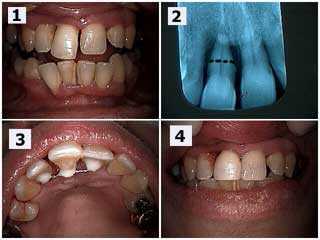
Mobile tooth loose teeth moving – how to treatment pictures. This patient wanted to try to save a very loose upper right central incisor tooth #8. Pictures 1) Upper right central incisor (#8) has extruded and moved toward the lip – labially – and a diastema – a front teeth gap space – has occurred. 2) The radiograph x-ray shows severe bone loss. The black dotted line shows the location for a potential root resection cutting if necessary. Root planing was performed after the teeth splint was bonded. The patient will return in three months for reevaluation with the Periodontist to determine the need for the tooth root resection. 3) Palatal image of the dental splint between teeth #’s 7 – 9. 4) Post-op photo. Same day. Notice the diastema was closed with dental bonding to hide the splint and the incisal edge of #8 was shortened.
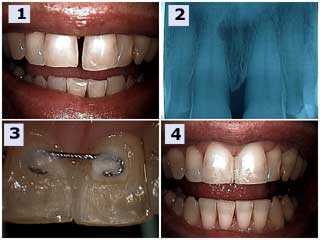
Mobile tooth loose teeth moving – how to treatment pictures. Treatment of a periodontally involved upper left central incisor #9. 1) & 2) Pre-operative photograph and radiograph. Note the angular bony defect in the radiograph xray. The patient reported that the tooth was getting longer and that he never previously had the teeth gap space between his two front teeth. 3) Palatal photo of the dental splint placed between teeth #’s 8 & 9. 4) Post-operative photo one hour later. Dental bonding was placed between the teeth to close the space also hid the palatal splint. The incisal edge of #9 was shortened and the teeth bite occlusion was checked and adjusted for fremitus – tooth vibration upon closing the mouth. Root planing was next performed and the patient placed on a three-month periodontal gum reevaluation.

Mobile tooth loose teeth moving – how to treatment pictures. 20 provisional temporary dental crowns teeth bridge, 14 teeth received root canal therapy and six teeth were extracted. Treatment time: one visit. Loose tooth teeth are common in dental fear phobia patients. Initial treatment can frequently be quick and relatively painless.
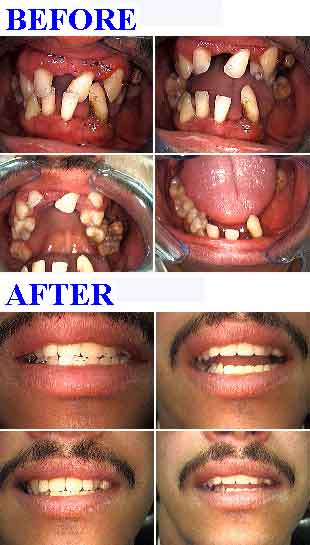
Severe gum disease in a 35 year old male who suffered from dental fear. Mobile tooth loose teeth moving – before and after pictures.
Loose tooth teeth are common in dental anxiety phobia patients. Initial treatment can frequently be quick and relatively painless. Dental fear patients like being offered multiple treatment options and particularly appreciate seeing a significant initial change quickly so they will complete a recommended treatment plan.
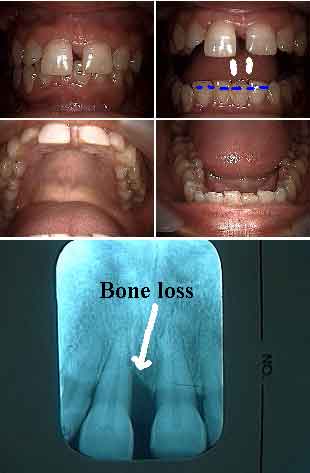
A combined bad bite and gum disease problem – occlusal – periodontal in a 40 year old female resulting in mobile loose front teeth. The moving front teeth has created a tooth gap space. Fremitus – vibration movement of tooth #8 upon closing the mouth was noted. Notice the deep bite. Consider either lower anterior orthodontic intrusion – teeth braces – or more likely perform incisal adjustment – see Sculpting. Next, periodontal gum scaling and root planing and then probably periodontal gum surgery in the maxillary anterior. Following healing of the gums consider either upper orthodontic movement to bring these teeth back palatally or dental bonding with a palatal splint after shortening the excessive length of tooth #8.
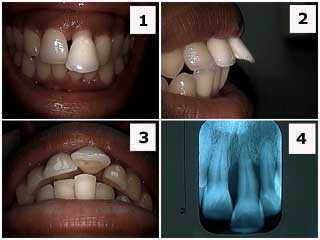
Mobile tooth loose front teeth – diagnosis and treatment when upper front teeth keep moving out of the mouth towards the lip – labial flaring.
1) Front teeth photo. 2) Side teeth photo. 3) Occlusal view. 4) Radiograph. This 24 year old patient was informed about her severe periodontal condition – gum disease – and that the prognosis for this tooth was guarded at best. She was informed that a thorough check-up was indicated. Orthodontics teeth braces is contra-indicated here because of the severe periodontal problem. If the patient accepts treatment on a tooth with a guarded prognosis it could include: scaling and root planing, open flap debridement of the gums – if necessary, root canal therapy and a dental crown for aesthetics and possibly a teeth splint. Otherwise, treatment could include just scaling and root planing and incisal adjustment. I personally would not rush to extract this tooth though the patient needs to be aware of this possibility.
1) Front teeth photo. 2) Side teeth photo. 3) Occlusal view. 4) Radiograph. This 24 year old patient was informed about her severe periodontal condition – gum disease – and that the prognosis for this tooth was guarded at best. She was informed that a thorough check-up was indicated. Orthodontics teeth braces is contra-indicated here because of the severe periodontal problem. If the patient accepts treatment on a tooth with a guarded prognosis it could include: scaling and root planing, open flap debridement of the gums – if necessary, root canal therapy and a dental crown for aesthetics and possibly a teeth splint. Otherwise, treatment could include just scaling and root planing and incisal adjustment. I personally would not rush to extract this tooth though the patient needs to be aware of this possibility.
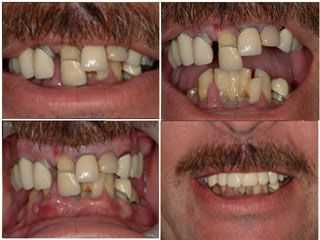
Mobile loose teeth are common in patients who are afraid of dentistry and dentists. Many patients are relieved to learn they are not alone and initial treatment can frequently be quick and relatively painless. The lower right photo shows the initial “after” photo of these before and after pictures.
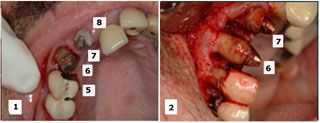
Selective tooth extraction – of a loose tooth – during periodontal gum surgery in a maxillary oral rehabilitation patient. The initial treatment plan considered saving teeth #’s 6, 7 and 9 while extracting #’s 5 and 8. During the oral surgery, tooth #5 was considered more stable – less tooth mobility – than #6 so tooth #5 was retained and #6 was extracted. The retained teeth will be used to support a fixed temporary dental bridge until dental implants are placed and healed.